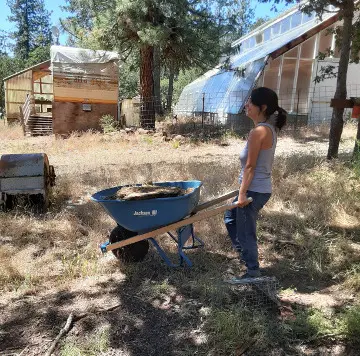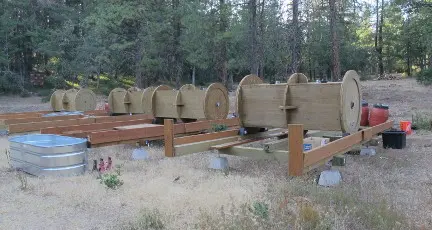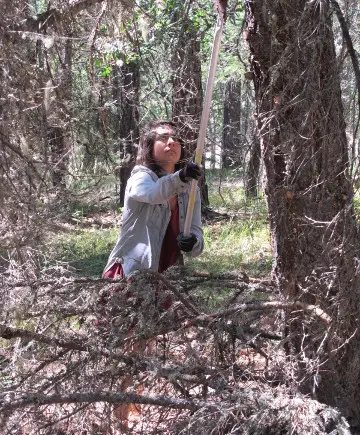Called Back to the Land
Alicia’s first impressions and reflections
July 2, 2021
Alicia: First Impressions
I, like many others, have been feeling a call back to the land, to be in community with like-minded individuals, and to reacquaint myself with the skills and ways of life of those who came before me. The ways of life which work with nature instead of against it, and that allow for people to truly thrive. I was elated when I found Windward, a place where I can answer to this yearning. But first, I wanted to take a look at the “lay of the land”, the groundwork that has been laid, and what’s going on.

Moving bunny poop to the garden
Windward is an intentional community of over thirty years dedicated to the mission of preserving and applying indigenous skills and technologies needed to create and sustain thriving communities. Windward is located in Klickitat County, southern Washington, just across the beautiful Columbia River. The property encompasses 120 acres of forested land. Oak and Ponderosa Pine are the dominating species of trees. Walking along the southern border you get sweeping vista views of the foothills, and on its northern boundry you’re in a thicket of trees, wild strawberries, and wildflowers.
About 5 acres are dedicated to living spaces for the community members. Right now it’s a mix of trailers, campers, converted shipping containers, and a couple log cabins. There is one main communal dining area with a full kitchen, pantry and a modern bathroom. The utilities are in place to support dwellings. There are four wells on the property, about 20,000 gallons of water storage tanks and a mile of underground water lines. There is electricity in all inhabited dwellings. We have indoor and outdoor showers, both with the luxury of hot water by propane. There is also good cell service and internet connection. We have a communal dining hall/kitchen that can comfortably fit about ten people; it is where we have our afternoon meal together. There is about an acre dedicated to garden space. That acre slopes down from North to South, and is terraced beautifully, with stones outlining each garden bed.
The community is in a restructuring process. Like everything in life, groups ebb and flow, people come and go, relationships are formed, and break apart. The biggest crew at Windward had seventeen members; currently there are six. We are in the delicate process of getting to know one another, getting to know the land, and figuring out how to move the community forward and pursue the worthwhile endeavors that are possible here. I feel extremely blessed to be able to join the community at this tender time, when many things have been put on hold due to lack of hands on deck, and to contribute to restoring breath and spirit to the vast potential of the land. Since I have a big interest and passion for gardening, it is my wish to bring the gardens back to life. There is easily enough space to grow enough food to feed the community.
There are many animal friends on the land including goats, sheep, pigs, chickens and rabbits. The sheep provide wool, which can be processed, spun and turned into clothing to keep us warm in the winter. All of the tools that are needed for that process are on the property. The chickens help to fertilize the land, and provide us with meat and eggs. The goats are wonderful companions and friends, and they also provide milk and meat. The pigs utilize our food compost, and are also used for meat. All of the animals are companions and friends, and are treated with respect and care. Hearing the crow of the roosters, the bleats of the goats and the snorts of the pigs always put a smile on my face.
In addition to the animals we have here intentionally there is abundant wild life. There are dozens of species of birds, including an owl that frequents the are between my dwelling and the southern border. Deer are often spotted on the eastern border of the property. At the first snowfall, tracks of elusive animals can be spotted; on one occasion a paw print from a big cat was found.
20 acres of the land is currently dedicated to Herland Forest, our Natural Burial Cemetery.This is one of the main functions of the organization; providing alternative death care options that are better for the environment and more personalized for the descendants and their loved ones. Natural Burial in this case means that the remains are not embalmed, there’s a shroud instead of a coffin, and no concrete vault to contain the remains. The grave is three feet deep as opposed to the usual four to six feet. With the shallow grave, the remains are able to actually return to the biosphere and nurture the forest.

A string of our NOR cradles
All graves are dug out by hand, to eliminate the disturbance caused by big machinery, like compacting the forest floor. A tree is planted on most graves in an effort to nurture the biodiversity of the forest and provide sustenance to the birds, bees, and animals that make the forest their home. Flowers are also planted on the grave sites to add beauty and a sense of rebirth. Two of the trees I saw were a cherry and a chestnut. Since our campground is adjacent to the cemetery, the deceased’s loved ones are able to camp near the grave, come visit, and spend time in the way that is best for them.
About half an acre is dedicated to the nation’s first Natural Organic Reduction facility. NOR is a process by which the remains of a body are processed essentially composted above ground in what we call a cradle. What is left at the end of the process is nutrient dense compost. The drive behind people wanting this service is that in the state of Washington, you are not allowed to bury a body on private property. So, someone who has a connection or attachment to a piece of land can choose to be processed by the NOR system, and then returned to the land as soil.
Reflections
Now, I’d like to touch on some underlying principles I saw at play that seem to be key in sustaining a happy and healthy community.
2 hour power
The first task I took part in was limbing trees. It’s a process in which dead or low limbs are sawed off of a tree. It serves many purposes, the main one being fire prevention, or giving less fuel to a potential fire. The second is that wood chips are needed for several of the systems on the land, and the limbs are chipped on-site to make those wood chips. The third purpose I saw was that it gives the forest a more open feel, which is an aesthetic bonus that leads to a more welcoming feel for the place.

Removing “ladder fuels” to make the forest safer from wildfire
After about 45 minutes of limbing I was told we were going to stop soon. I thought it was silly to only work for an hour, but I soon learned that was one of the ways the community approaches work tasks; each task is focused on for about an hour, and then we move on. It wasn’t long before I turned from skepticism to appreciation for this way of working.
It was a shift for my modern mind. All of the examples around me tell me that one needs to work 8 hours a day to get anything done, to have success, to reach their goals, to pay the bills. So whittling down the work time to one hour felt unproductive at first. I soon saw that this guideline was a very sustainable approach to work. Since I worked for one hour, as opposed to four or eight, I left the task feeling still energized and happy about the work we had just completed. I left feeling like I could do the same thing again tomorrow.
The main point I saw was that it was a sustainable way to approach the things that needed to get done. I felt enthusiastic about resuming the task again the next day, knowing that I would be able to do meaningful and constructive work for a short period of time, and not have to exhaust myself doing it. It creates a great balance of work and rest, and frees up ample time to be able to focus on what is meaningful and important to you in other areas of your life. Whereas the modern model breeds resentment and frustration towards work, as it’s seen as something that takes up all your time, this other model creates an environment of willingness and optimism around work.
Autonomy and Interdependence
One of the main questions asked in regard to living in community is how do we contribute, connect and depend healthily on each other while also remaining autonomous and true to ourselves? I have a deep personal interest around this topic. The understanding and belief is that when we have a strong, solid foundation within ourselves; when we have the ability and willingness to be honest with ourselves; when we can provide our basic needs for ourselves; when we have a healthy relationship with our inner emotional landscapes, then we can healthily provide and receive support for ourselves and the community at large.
By everyone being strong in themselves and clear in what works best for them, we can establish healthy bonds of affection, rooted in the recognition that “going at it alone” is an arduous task, while walking side by side with loved ones is a joyous experience. The goal is to nurture relationships that are rooted in interdependence, rather than codependence. The key difference, as I see it, is that interdependence is a recognition that we are strong and capable within ourselves, and that we can also enjoy and value deep connections with others, and codependence being that we don’t feel empowered in ourselves and feel we need others to fill all of our gaps.
I surmise many of us live out a combination of both, and there are no hard and fast answers to these deep, complex questions.
One thing we can do is create an environment in which autonomy is encouraged. One way this is done at Windward is that everyone has their separate dwelling; live separately and visit often. This allows everyone to nurture their sense of autonomy, while also knowing that you have friends all around, and when the time is right, you can come together with them.
Another way Windward encourages autonomy is by the guideline that everyone has their own stream of income, ideally one that can be managed remotely, but there’s a world of craft options that can be developed on site. This ensures that everyone strengthens and maintains their own dignity by being able to provide for themselves financially. This creates a sense of independence and bypasses all the challenges and stickiness around having to borrow money from others.
This also allows people to feel free. No one is at Windward just to make money, so no one feels they have to stay for the sake of a paycheck. It creates a space where people are choosing to be a part of the community for reasons far more deep and meaningful than money.
Creating Value
Another key aspect at the heart of what makes Windward a unique and self-reliant model is the recognition that moving away from focusing on making money towards creating value is key. The dollar has no intrinsic value it only has the value we give it, and while it is an extremely volatile tool, the dollar is rapidly losing its value.
We need to start asking ourselves, if I didn’t have money to offer, what else do I have of value? This means things that are needed by others that can be traded if needed. Like food, animals, clothing, tools, etc. I’d like to note that I don’t think we need the premise of the dollar crashing to move toward creating value in our lives and communities. It isn’t a doomsday survival thing; it’s an innately human need that we’ve strayed from. To create things that will serve ourselves and our loved ones, to create from raw inspirations and passion, from true needs, to express, give and receive. To move away from having a price tag on our time. To move away from trading our time doing things we don’t feel passionate about just for some dollars. Moving into a model where everything we do directly benefits the quality of our lives, and that of the community. Taking our power back and cutting out the illusory middle man, the paper floating around with numbers on it.
One task I found directly exemplary of this principle was splitting wood. We have a manually operated machine that makes splitting wood easy, safe and effective. I knew that my time and energy was going towards providing logs for myself and the community to keep ourselves warm and happy during winter. Also, in time of need, fire ready logs would be extremely valuable to someone who hadn’t prepared in that way.
Leaning on Each Other
Another enriching aspect of Windward is the value placed on community, of everyone doing their part to extend themselves for the well being of the whole. For example, we typically gather for lunch every day. Each member makes a noon time meal once a week. This allows for us to all eat together every day without it becoming a burden on just one person to cook every meal.
In conclusion, Windward is a very unique place. It’s been an ongoing unfoldment in an experiment of developing a working model of a better way. One of the key principles that the community embodies is that we don’t focus on trying to fix the existing way, but rather we’re working to create a completely new way that renders the old way obsolete. We are the children of heroes, of people who made it. When we take the time to learn from those who came before us and blend that wisdom our current wants and needs, we can amplify our chances of having success.
